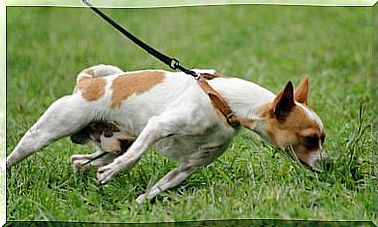What Do I Do If My Dog has A Seizure?
When we find ourselves facing an epilepsy attack with seizures in our dog, the first thing we should know is that we will have to keep calm, lay the animal down, prevent it from swallowing its tongue, allow it to recover and apply the recommended treatment.
A greater propensity of some races to convulsions
Epilepsy attacks are more likely to occur in certain breeds : German Shepherd, St. Bernard, Setter, Beagle, Poodle, some Dachshund and Basset Hound. The first epileptic fit is often manifested in dogs between the ages of six months and five years. It is necessary to learn to act, as epilepsy does not imply the death of the animal, but it can have serious side effects.
Precise steps during fits and seizures
The so-called idiopathic or essential epilepsy in dogs is a brain disorder that is characterized by symptoms similar to those manifested in people suffering from the same problem. When an attack starts in an unpredictable and also random way, there is an energy discharge in the brain that causes pedal movements in the extremities in the dog, abundant salivation, involuntary urination or defecation and loss of consciousness. We have to be prepared for this situation.
The first thing to do is to remain calm and put the animal in a position where it does not bump or fall from a high place. We will treat him with great care, as he is in an especially delicate situation. Ideally, lay him down on a soft surface such as a mat or some pillows so he stays comfortable and doesn’t get hurt from seizures.
There are those who advise that we avoid the animal swallowing its own tongue, as this way it is possible to maintain oxygenation. But common sense tells us that if we put our hand in the dog’s mouth we run the risk of being bitten. Once the epileptic seizure is finished, the dog must be allowed to rest in a quiet place, as he will be exhausted. The veterinarian will indicate the correct treatment when considered convenient, usually consisting in the administration of a muscle relaxant, such as Valium, which should be applied rectally. The owner himself can apply this relaxant to the dog when he suffers from an epileptic fit.
Epileptic dogs and seizures that warn
Epileptic seizures can be of greater or lesser intensity. There are some indications in the animal’s behavior prior to the attack, such as a dog that is more nervous and restless than usual.
If we anticipate the attack, we can put first aid into practice, such as placing the dog in a place where there is no danger that he will hit his head or risk falling from some considerable height. It is also recommended to lay the dog down on a soft surface, preferably on the ground so that he does not fall.
duration of seizures
Although in the eyes of the owners an attack may seem eternal, in fact these attacks do not last longer than two minutes, after which time the animal will be disoriented and very tired. Idiopathic epilepsy in dogs is incurable and most likely will require lifelong treatment.
It can’t be detected through exams or radiographs and, in general, it doesn’t need urgent treatment, except in cases of attacks that are repeated in a short period of time, something that can be very dangerous for our pet, and in this case , it will be necessary to proceed with a treatment based on barbiturates.
The animal does not suffer during the attack, although it appears otherwise.
useful advice
When we observe the symptoms, the best thing to do is to go quickly to a veterinarian. The treatment that the specialist prescribes will have to be followed to the letter, so that the epileptic episodes are reduced as much as possible.
In fact, seizures are a symptom of an illness in the animal’s brain, just as diarrhea is a symptom of an illness in the digestive tract. On many occasions, it is possible to determine what type of illness is causing the attacks: a tumor, a congenital malformation, or a stroke, but sometimes it is not possible to determine the cause, and in the latter case the epilepsy is called idiopathic.
When in veterinary medicine a disease is called idiopathic, it is usually because the causes that give rise to it are not known.









